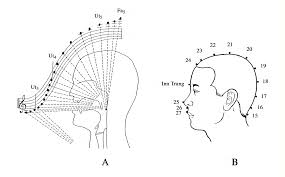1. Exploring the Mask: Foundation and Richness of Sound
The concept of “Singing in the Mask” is the essential foundation for controlling, nuancing, and above all, enriching your singing. All sound study begins here: it involves initiating the vibration of the hollow cavities, bones, and membranes, the resonators located in the head and sinuses.
The Mask:

I observed a student who, by singing nasally, caused a muffling of the sound. By exploring the mask, she was able to break this habit and broaden the components of the sound to recreate her own resonance chamber.
Targeting the musical spectrum in all acoustic cavities of the head is crucial for achieving richness of sound.
Visual Aids 2 and 3 – Musical Spectrum and Acoustic Cavities.
2.

3.

Reminder / Good to Know: The Fundamentals of Sound
The study of frequency or fundamental sound is the pillar of vocal technique and is summarized by the acronym D.I.H.T.:
| Component | Meaning |
| Direction | Origin (of sound) |
| Intensity | Volume and Projection |
| Pitch | Note Frequency |
| Timbre | Color and Quality of Voice |
Additional Information: Harmonics
The timbre of your voice will transform as you progress in your vocal work. This enrichment is due to harmonics. (Integrate here the table or diagram of simplified essential details to remember about “harmonics”.)
I invite you to a comparative listening to grasp the impact of this work:
- My version: Listen to my song, “Si Jolie – Vocal lessons Paris, Laura Dauzonne” (in D flat), where I use accentuations to better place the necessary breathing moments.
- Original Version: Compare with Yves Montand’s, “Yves Montand – Si jolie” (performed in C):
2. My Vocal Philosophy: To Enhance Rather Than Shape
According to my methodology, vocal work does not seek to shape or confine voices into a specific box; it aims to explore them to reveal and enhance them. Forcing is not good. It hinders learning and progress. It is by respecting this methodology that the voice is enriched with harmonics and gradually built through regular exercises.
3. Anchoring and Posture: The Body as a Tool
To sing well, it is fundamental to study your posture because the body is an instrument that engages the entire being.
Anchoring
- Position: When standing, ground yourself through anchoring.
- Knees: Slightly bend your knees so they are flexible and slightly mobile (without overdoing it).
- Intention: Rather than tensing up by telling yourself to “stand straight,” relax completely; let go and trust yourself.
Tip: Do not view this positioning as a constraint. Good anchoring predisposes the entire body to singing, allowing it to relax while standing upright.
Posture Exercise: The Puppet (Cervical Alignment)
This exercise helps align the cervical spine and correctly influence airflow:
- Sit comfortably on a chair, without leaning back.
- Relax your shoulders by pushing them towards the floor.
- Imagine a string attached to the top of your head and someone pulling it: lengthen your neck while breathing normally.
- Conscious Breathing: The Role of the Diaphragm
Note: You will notice that your chin is slightly tucked inward. You should only feel a slight tension or stretch, not sharp pain.
Diaphragm Exercise (Abdominal Contraction)
This exercise is essential for becoming aware of the diaphragm’s role and relieves lower back pain.
- Lie comfortably on your back, with knees bent.
- Place your fingers firmly on the sides of your abdomen, between the hip bones and the ribs.
- Focus on regular and deep breathing.
- Contract the abdominal muscles (transverse muscle) without ever moving the pelvis, buttocks, or rib cage. The navel should be pushed slightly backward and upward.
- Maintain the contraction for at least 30 to 60 seconds.
Note: If the contraction is difficult, exhale quickly to expel all the air. At the end of the exhalation, you will feel the abdomen firm up and the pelvic floor muscles (used to hold back the urge to urinate) contract. Then reproduce this sensation.
Progression (5 Stages) If the exercise becomes easy and no longer causes any pain, progress as follows:
- Repeat the exercise in a seated position, with a straight back.
- Repeat the exercise standing.
- Contract the transverse muscle while walking.
- Repeat the exercise on your back, seated, then standing.
- Visual aid: The respiratory movement.

The Piston Diaphragm (Summary)
The diaphragm, often compared to a parachute canopy (dome-shaped), is a major muscle. Personally, I imagine it as a piston:
The diaphragm is a piston that processes the incoming air to send it, like a spring (when it compresses), to the musical spectrum of the head. This mechanism targets the note you wish to resonate in all acoustic cavities.
- The Ways of Singing, by Jean-Pierre Blivet;
- Building Your Voice, by Marie-Jeanne Rodière;
- Physiology and Art of Singing, Marie Hutois;
- The Liberated Voice, Yva Barthélémy.

